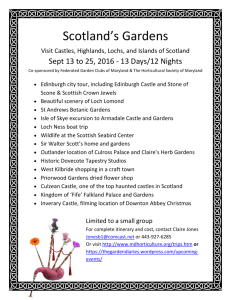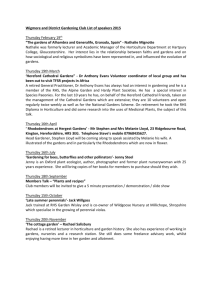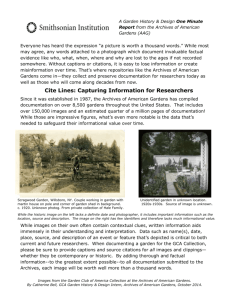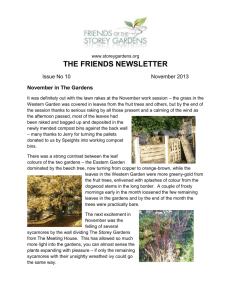Southern Gardens
advertisement
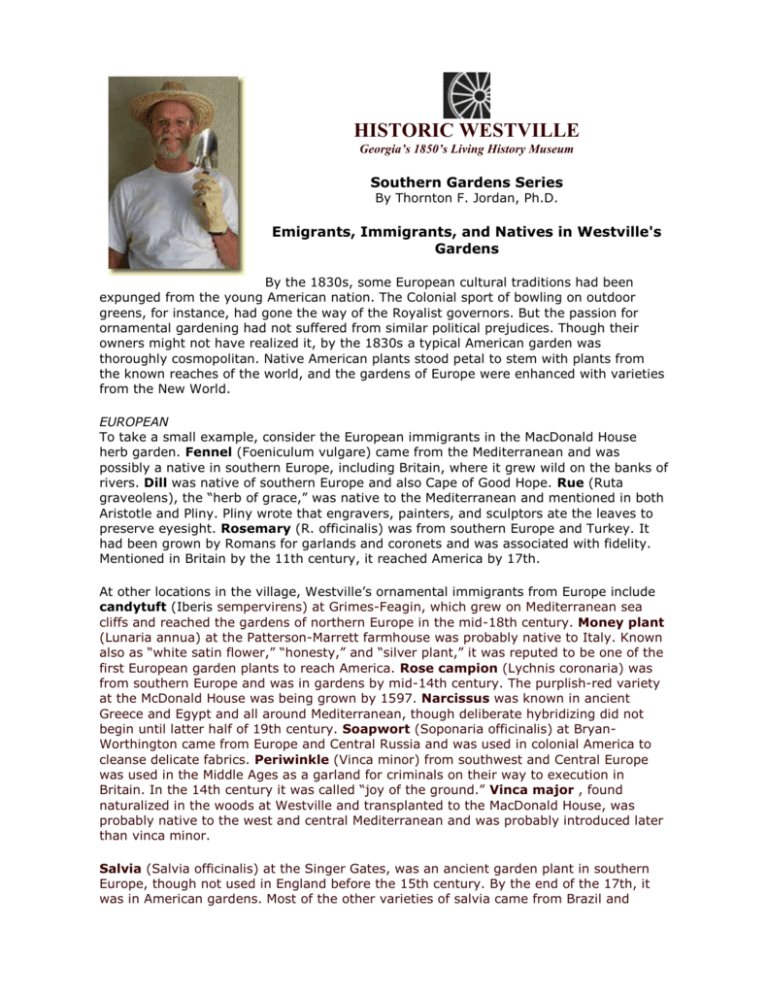
HISTORIC WESTVILLE Georgia’s 1850’s Living History Museum Southern Gardens Series By Thornton F. Jordan, Ph.D. Emigrants, Immigrants, and Natives in Westville's Gardens By the 1830s, some European cultural traditions had been expunged from the young American nation. The Colonial sport of bowling on outdoor greens, for instance, had gone the way of the Royalist governors. But the passion for ornamental gardening had not suffered from similar political prejudices. Though their owners might not have realized it, by the 1830s a typical American garden was thoroughly cosmopolitan. Native American plants stood petal to stem with plants from the known reaches of the world, and the gardens of Europe were enhanced with varieties from the New World. EUROPEAN To take a small example, consider the European immigrants in the MacDonald House herb garden. Fennel (Foeniculum vulgare) came from the Mediterranean and was possibly a native in southern Europe, including Britain, where it grew wild on the banks of rivers. Dill was native of southern Europe and also Cape of Good Hope. Rue (Ruta graveolens), the “herb of grace,” was native to the Mediterranean and mentioned in both Aristotle and Pliny. Pliny wrote that engravers, painters, and sculptors ate the leaves to preserve eyesight. Rosemary (R. officinalis) was from southern Europe and Turkey. It had been grown by Romans for garlands and coronets and was associated with fidelity. Mentioned in Britain by the 11th century, it reached America by 17th. At other locations in the village, Westville’s ornamental immigrants from Europe include candytuft (Iberis sempervirens) at Grimes-Feagin, which grew on Mediterranean sea cliffs and reached the gardens of northern Europe in the mid-18th century. Money plant (Lunaria annua) at the Patterson-Marrett farmhouse was probably native to Italy. Known also as “white satin flower,” “honesty,” and “silver plant,” it was reputed to be one of the first European garden plants to reach America. Rose campion (Lychnis coronaria) was from southern Europe and was in gardens by mid-14th century. The purplish-red variety at the McDonald House was being grown by 1597. Narcissus was known in ancient Greece and Egypt and all around Mediterranean, though deliberate hybridizing did not begin until latter half of 19th century. Soapwort (Soponaria officinalis) at BryanWorthington came from Europe and Central Russia and was used in colonial America to cleanse delicate fabrics. Periwinkle (Vinca minor) from southwest and Central Europe was used in the Middle Ages as a garland for criminals on their way to execution in Britain. In the 14th century it was called “joy of the ground.” Vinca major , found naturalized in the woods at Westville and transplanted to the MacDonald House, was probably native to the west and central Mediterranean and was probably introduced later than vinca minor. Salvia (Salvia officinalis) at the Singer Gates, was an ancient garden plant in southern Europe, though not used in England before the 15th century. By the end of the 17th, it was in American gardens. Most of the other varieties of salvia came from Brazil and Mexico, including “cardinal flower” (Salvia fulgens), and blue salvia (Salvia patiens). Sweet William (Dianthus barbatus) at Grimes-Feagin, came from western Europe, the Near East, and Turkey. Henry VIII grew it at Hampton Court and Jefferson at Shadwell in 1767. Tansy (Tanacetum vulgaris) was native to England and in gardens by Middle Ages. Feverfew (Tanacetum parthenium) at Bryan-Worthington, was probably native to southeast Europe and naturalized in Europe and North and South America. Originally garden lupines all derived from European crop species. L. alba from the Balkans and the Aegean, the the Romans used for oil and fodder. L. luteus was from southwest Europe and was a crop plant but also a garden plant used for perfume since the late 16th cent. The first perennial was introduced from Virginia in 1637, L. perrenne (now lost) The blue-purple lupine arrived from the west coast of America in 1826 (L. polyphyllus). The madonna lily (Lillium candidum) was possibly from Anatolia. The Greeks imported it from Asia Minor as salve or ointment, sacred to several goddesses and the Romans distributed it throughout the Empire. It reached America by 1830. From further reaches, among the vegetables grown occasionally in Westville’s demonstration plots, pumpkin was native of India and the Levant. Cucumber, originally from the East Indies, had been cultivated by Egyptians and esteemed by Romans. It was introduced into England in 1573 and made its way to the American colonies. Sweet potato was a native of both China and India. It was first cultivated in England in 1597 and is the potato mentioned in Shakespeare. The “Irish potato” was scarcely known at the time. Garlic was native of Sicily and South France. FAR EASTERN The Far East provided a number of other immigrants. Impatiens balsamini, or “Touch Me Not” was a native of India, Malaya, and China. Chinaberry, or “Pride-of-China,” Pride-of-India,” “Indian lilac “was introduced from Asia by Michaux. Hostas began to appear in England from China & Japan in 1780s but was not grown much until 1830s. By this time H sieboldiana was common in London gardens, because it didn’t mind the smoke pollution. Day lilies (Hemerocallis) were originally Asian. The lemon-yellow, perfumed daylily, H. flava, was probably native to Asia, though it had been in Europe so long that it was once thought native to foothills of southern Alps. It was common in country gardens in 1660s in Europe and popular in American cottage gardens by 1800s The orange, tawny H. fulva was grown by the Chinese for beauty and edibility. The Chinese called it “flower of forgetfulness,” because it supposedly caused loss of memory and thus of sorrow. In Europe it was used for “hot swellings of the dugges after childbirth.” In 1860 double form of H. fulva was brought from Japan and was sold in London by 1861. In 1864 a variegated form arrived, and both were known as “kwanso” types. H. maculata , with a bronze patch on each petal arrived 1897. By the end of 19th century new species flooded Europe Some arrived in America and were re-exported to Europe. By 1900 modern types were being bred in America. Currently there are about 7,000 varieties. A village like Westville represents an American town on the absolute western frontier of the United States in the 1830s, but a trip through its period gardens demonstrates how cosmopolitan was the world of even the simple frontier gardener. After Jefferson rode his horse home from Washington to Monticello in 1807, he had already begun thinking about the end of his second term as president in two years, so he sat down to plan his flower gardens. Visitors to Monticello today will be told that 25% of his species were natives. That meant, of course, that 75% of them were immigrants. However, while American gardeners owed many of their ornamental and food plants to 2 immigrants from far shores, North and South America were, after all, the New World. As such, even as early as the 16th century, Europeans were eager to try our natives. Among our North American emigrants, the spiderwort or widow’s tears (Tradescantia virginiana) in the McDonald house garden was native to eastern North America . It was introduced to Britain after 1654 and was one of the first colonial American ornamentals to be grown in English gardens. Jerusalem artichoke, a close relative of the sunflower, was originally a native west of the Mississippi River that was taken to Europe in 17th century where it was known as the “potato of Canada.” Its name, though, is a misnomer. “Jerusalem” is a corruption of the Italian girasole, or sunflower, and artichoke was from the fancied resemblance of the boiled root to a true artichoke. Gaillardia, or “blanket flower” at the Grimes-Feagin house was a Texas native. Evening primroses (Oenothera) are mostly American. Oenothera grandiflora was an American native, andOenothera biennis, a tree primrose, was sent from Virginia to Padua as early as 1619. Phlox subalta [McDonald house] was sent by Bartram from America to England in 1745. Phlox paniculata [Grimes-Feagin house], or “common purple” phlox was introduced to England 1730 and the first garden variety was deveolped in 1824. The parent rhododendrum (Rhododendrum catawbiensee) was found in 1799 on the Roan River in the mountains between North Carolina and Tennessee by John Fraer. Latin America offered another rich source of ornamentals for the Old World. Oenothera. longiflora, an uncommonly large, showy yellow type of evening primrose, was a native of Buenos Aires. Four O’clock (Mirabilis jalapa) [Grimes-Feagin house] was known as the “Marvel of Peru.” Seeds were brought from Peru to Spain in the 16th century and thence to England before they emigrated to America. Pineapple sage (Salvia rutilans) [McDonald house] came from Mexico. Nasturtium (Tropaeolum mahus) [GrimesFeagin], a native of Peru, was introduced to Spain and thence into to England in 1681. Penstemon, the popular border type (Penstemon hartwegii) came from Mexico in 1825 but was not grown outside until 1838. Fifteen new species were introduced between 1827-1834. By 1839 it was considered one of the greatest boons conferred upon English gardens by the discovery of the New World. Verbena was introduced to England from South America (1826-1837) and was for a time synonymous with “bedding” plants. But like fabrics, colors, and architecture, flowers go in and out of fashion. Take the case of the petunia --from “petun,” a Brazilian word for tobacco--which was introduced into Europe in the 1830s. It offered a sensational splash of color in the garden, and by 1840 there were many hybrids. But by the 1880s verbenas and petunias were losing their fascination, giving way to pelargoniums, which we know by the common name of geraniums. They were introduced to Europe from South Africa in 1631 but didn’t become a fashion rage until the 1880s. Another variety, Geranium maculata , came from North America in 1732. Poinsettia was introduced 1833 by Joel R. Poinsett of Charleston, who was minister to Mexico under Andrew Jackson. Helianthus or sunflowers were all from North and South America. They had made their way into European gardens by the 16th century. By the 1750s, smoke and fog in London made the perennial form more popular. Among the North American trees that made their way back to Europe, the Magnolia grandifloras, or “big laurels” at McDonald and Grimes-Feagin, were native in states south of North Carolina. The large leaf magnolia (Magnolia macrohylla) Michaux discovered near Charleston in 1789 and introduced it to Europe in 1800. Between 17871796, Andre Michaux also discovered Magnolia cordata, or the “yellow cucumber tree,” near Augusta. He sent it to France and never found another one. Many years 3 later, Louis Berkmans discovered another in the woods 18 miles south of Augusta. Fringe tree or Grancy Graybeard (Chionanthus virginica) was discovered in Virginia. Berkmans nursery in Augusta, by the way, called “Fruitlands,” was one of the two largest nurseries in the South before the Civil War, the other being in Richmond, Virginia. In his 1861 catalogue, Berkmans listed 1,300 varieties of pears, 900 apples, 300 grapes, 300 peaches, 100 camellias and 100 azaleas. Many of the varieties of camellias and azaleas he cultivated for outdoor culture he imported from Belgium, Germany, France and Japan The catalpa trees that line the street in front of the McDonald house were native to American states south and west of Virginia. The pecan at Grimes-Feagin house was a native, originally found in Missouri and Arkansas, in portions of Ohio, and on the Wabash and Illinois rivers. Osage orange (possibly at Patterson-Marrett farmhouse) was native to the Arkansas River and tributaries of Mississippi River. Fine-grained and very very elastic, its wood was used for bows, hence its common name Bodac, a corruption of bois d’arc. Sweetgum was the most widely diffused tree in America, though its use is limited. It does not split well for firewood, and is unsuitable for boat building. In fact, I have run across a reference to it as “alligator wood,” implying that it readily sinks. If sawn, it can be used for furniture, though it is not popular. According to its common name in Europe, “liquid amber, ” it enjoys a somewhat higher status there. Its gum was exported from Mexico and used as a styptic. In shops it is called “white balsam of Peru.” Both a stimulant and an aromatic, it has been long used in France as a perfume, especially for gloves. Jefferson died July 4, 1826, long before Congress funded the four expeditions of John Frémont to explore the west in the 1840s. Frémont brought back Western native flowers which are now easily familiar in American and European gardens, including sunflowers, gaillardia, rudbeckias, verbenas, yuccas, lupines, asters, penstemons, goldenrods, phloxes, larkspurs, and aquilegias. Had Jefferson lived, no doubt he would have tried them at Monticello. Sources: Leighton, Ann. American Gardens of the Nineteenth Century. Amherst: U. Mass. Press, 1987. Betts, Edwin M. and Hazelhurst Bolton Perkins. Thomas Jefferson’s Flower Gardens at Monticello. Charlottesville: U. Press of Virginia, 1986. 4


